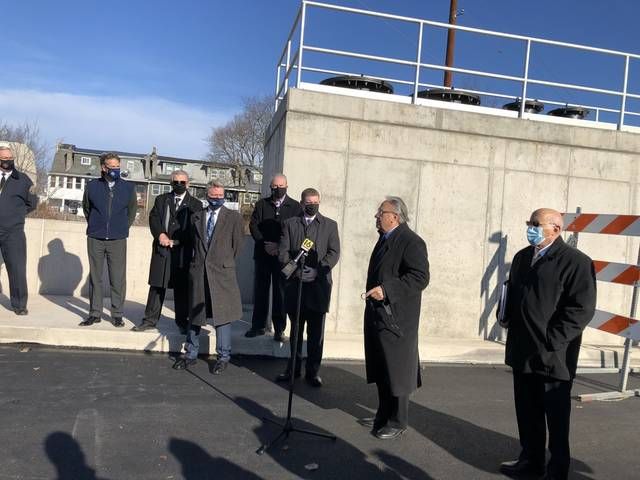Click here to subscribe today or Login.
WILKES-BARRE — When state Sen. John Yudichak remarked how gloomy this year has been, he wasn’t referring to the weather.
On a chilly, yet sun-drenched Thursday morning, Yudichak returned to Solomon Creek wall reconstruction project to mark its completion and celebrate the accomplishment achieved through the collaborative effort of city, county, state and federal governments.
“There’ve been very, very few bright spots in the year 2020. But, today is a tremendous day for the city of Wilkes-Barre, particularly the neighborhood here in South Wilkes-Barre,” Yudichak said.
A new pump station stood at the intersection of Vulcan and Brook streets, downstream from where a section of the wall fell into the creek bed nearly four years ago. The collapsed section, built in the 1930s when Franklin Delano Roosevelt was president, has been replaced as part of a new reinforced concrete wall stretching for several blocks from South Franklin to Vulcan streets.
The wall and pump station projects, bid out and constructed in two phases by contractor Don E. Bower Inc. of Berwick at an estimated total cost of $5.2 million, came in on time and under budget. Engineered as flood protection, the project provided long-awaited safety and security for residents and businesses in the densely populated low-lying area, Yudichak pointed out.
“For better than 25 years, the people of South Wilkes-Barre have watched as politician after politician stood on this flood control protection system and promised results, only to be frustrated when those results were not delivered,” Yudichak said.
The wall collapse heightened the need for action and prompted politicians, Yudichak included, to search for funding. Gov. Tom Wolf and Department of Community and Economic Development Secy. Dennis Davin came through and helped with a novel plan to use disaster recovery money for the project, Yudichak said.
The state awarded more than $6 million, much of it in the form of disaster recovery money, and the city used more than $4 million from a bond issue.
But the city was eligible for just a portion of the state funds tied to disaster relief from tropical storms Irene and Lee in 2011. And not all of the money from the bond was needed, leaving the city to request it be allowed to use approximately $1 million for a new elevator at City Hall.
Even though the project was well underway when Wilkes-Barre Mayor George Brown took office in January, he credited the prior administrations of mayors Tom Leighton and Tony George for their work.
Past and present city employees also deserved recognition, Brown said, naming former Office of Economic and Community Development Director Kurt Sauer, his replacement Joyce Morrash Zaykowski and Deputy City Administrator Butch Frati.
City Council assisted as well, Brown said. Council members Bill Barrett, Mike Belusko and Tony Brooks attended the ribbon-cutting ceremony Thursday.
“I just want to say it’s amazing what teamwork can do,” Brown said.
State Rep. Eddie Day Pashinski, D-Wilkes-Barre, agreed. “So this is what it takes. It takes a team,” he said.
Waller Street resident Rich Williams had kept on eye on the project since it began in late 2018. He listened as Mark Boris of Borton Lawson Engineering explained the workings of the pump station.
“It didn’t take much for the storm system to be overtaxed,” Boris said.
When heavy rains fell, the city parked dump trucks on top of storm system covers to secure them in place and prevent the water from flowing onto the streets. The pumps, with a capacity of 45,000 gallons a minute, will pump the storm water into the creek, Boris said.
“If it does what it says it will do, I’m very satisfied, ” Williams said.
Reach Jerry Lynott at 570-991-6120 or on Twitter @TLJerryLynott.





